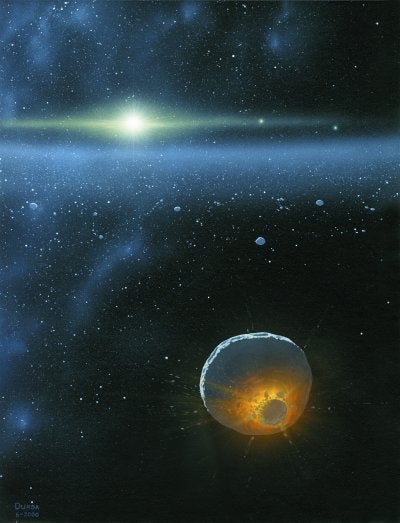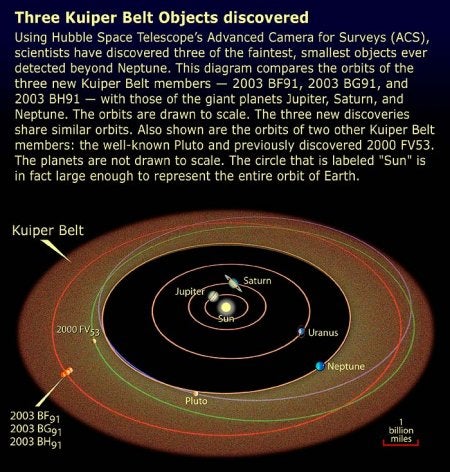
The Edgeworth-Kuiper Belt is named for British astronomer Kenneth Edgeworth and Dutch-American astronomer Gerard Kuiper. (Many refer to it as simply the Kuiper Belt.) Dan Durda December 8, 2003Lying far beyond Neptune’s orbit and harboring billions of icy objects, the Kuiper Belt is the final frontier of our solar system. Believed to be the frozen, 3.5-billion-year-old remains of the early protoplanetary disk surrounding the Sun, this far-flung planetoid population continually puzzles astronomers regarding its true origin. Now, more than ten years after its initial discovery, the Kuiper Belt finally is revealing tantalizing clues to its ancient heritage. A new study indicates this ring of icy debris actually formed much closer to the Sun and was steadily pushed outward by the planet Neptune.
So far, astronomers have cataloged more than 900 bodies in the Kuiper Belt, some more than 620 miles (1,000 kilometers) in diameter. They believe larger Kuiper Belt objects, like planets, formed from smaller, colliding bits and pieces that gravitationally stuck together.
According to this model, however, for the Kuiper Belt to have formed in its present position, it would have to hold more than ten times the amount of material that makes up Earth. Curiously, all telescope surveys indicate there is a hundred times less material currently contained in the Kuiper Belt. This has left scientists scratching their heads, trying to come up with theories to explain this “missing mass.”

The orbits of three newly discovered Kuiper Belt Objects are shown in this illustration. NASA / A. Feild (STScI) Using computer models and simulations, Harold Levison of Colorado’s Southwest Research Institute and Alessandro Morbidelli of France’s Observatoire de la Côte d’Azur examined possible evolutionary scenarios for the Kuiper Belt and suggested a promising answer that could account for the observed lack of material there.
Instead of figuring out how the Kuiper Belt lost more than 99% of its original material, the two astronomers argue that none of it is missing — the Kuiper Belt simply spread out. Originally, they suggest, there were no objects beyond Neptune’s present position around 30 astronomical units (AU). But material now in the Kuiper belt migrated out to 50 AU during the final stages of planet formation.
“We really didn’t solve the mass depletion problem, we circumvented it,” explains Levison. “According to our work, the void beyond Neptune was probably devoid of objects.”

This picture of Neptune was produced from the last whole-planet images taken through the green and orange filters on the Voyager 2 narrow-angle camera. The images were taken at a range of 4.4 million miles from the planet, 4 days and 20 hours before closest approach. The picture shows the Great Dark Spot and its companion bright smudge near the center of the image. On the west limb the fast moving bright feature called Scooter and the little dark spot are visible. These clouds persisted as long as Voyager’s cameras could resolve them. NASA / JPL Astronomers believe Neptune originally formed about 20 AU from the Sun and drifted outward to its stable orbit, where it resides today, by transferring energies from gravitational interactions during close encounters with large objects. Levison and Morbidelli’s model proposes that many of these objects ended up being ejected to the outer solar system, forming the Kuiper Belt.
“One of the puzzling aspects of Neptune’s migration is why it stopped where it did,” says Morbidelli. “Our new model explains this well. Neptune migrated until it hit the edge of the protoplanetary disk, at which point it abruptly stopped.”
Reporting their findings in the November 27 publication of Nature, the authors state that while their theory explains many of the observable characteristics of the outer solar system, it also presents profound implications for understanding how the solar system developed as a whole. Andrew Fazekas is an astronomy columnist based in Montreal, Canada, who frequently writes for magazines, newspapers, and the Canadian Space Agency. He currently does science news commentary for both radio and television, teaches backyard astronomy at Vanier College, and is an editor at the American Association for the Advancement of Science.
Search for other articles by this author Andrew Fazekas is an astronomy columnist based in Montreal, Canada, who frequently writes for magazines, newspapers, and the Canadian Space Agency. He currently does science news commentary for both radio and television, teaches backyard astronomy at Vanier College, and is an editor at the American Association for the Advancement of Science.
Search for other articles by this author





